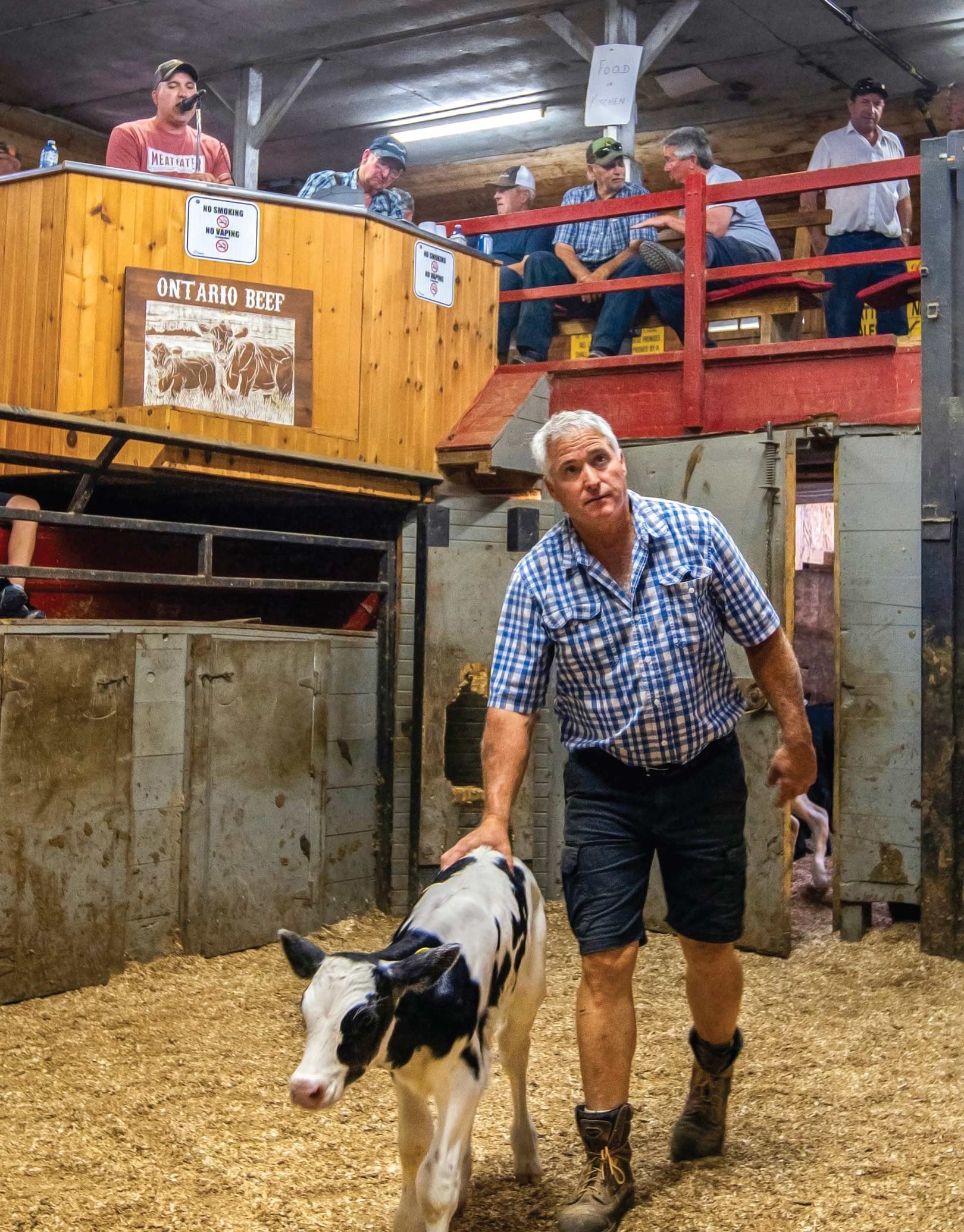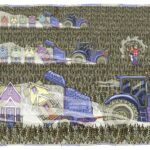


Every Tuesday morning farmers in their pickups roll up to a dusty barn just east of Campbellford, which comes to life under the rapid-fire patter of the auctioneer, amidst the cacophony of bleating sheep, bawling cattle and grunting pigs.
Down in the auction pit, Dave DeNure is trying to keep a young Holstein calf moving on its spindly legs to prove that it’s healthy. But he’s also eyeing the crowd for potential bidders.
Oh, and he’s avoiding a second calf that has been let into the pit because it is next up for sale.
If DeNure sees a bidder, he’ll shout and point them out to his son Brad, the fast-talking auctioneer, who is at the top of the ring about 15 feet up. As the bidding heats up, Brad continues his nonstop patter, pushing for the best possible price, watching for a subtle wrist flick or nod to register a bid from one of the buyers and finally hammering down the sale. The entire process takes less than 30 seconds and it’s on to the next calf.
Welcome to a normal Tuesday at the Hoards Station Community Livestock Exchange, better known to farmers and area residents as the sales barn. Livestock sales have been taking place here since 1949; in those early days they were held outdoors, inside a ring of snow fencing.
The sales barn, located on County Road 8 between Campbellford and Stirling just seven kilometres down the road from the Empire Cheese Cooperative, was started by auctioneer Ray Williams. He sold the operation to Delbert Hickson, DeNure’s grandfather in 1959. Delbert sold the business to his children Carl and Marie in 1971, and in 1992 Carl sold his shares to his nephew, Dave, who operated the barn with his mother Marie until she retired, and he took full control.
Now, after 64 years in the family, the business, the barns, an adjacent home, and 100 acres of farmland are for sale, listed at $1.75 million, because Dave and Brad want to focus on their extensive cattle raising operations.
Visiting the sales barn is an experience, even for someone who doesn’t want to buy a calf, steer, pig or sheep. In good weather the parking lot has up to a dozen vendors offering live chicks, plants, fresh vegetables, clothes, antiques and just plain junk.
Inside you can buy a burger or hotdog, or a full lunch supplied by a local church or community group. Recently members of St. Mary’s Catholic Church in Campbellford offered a beef dinner with potatoes and veggies, complete with coffee or tea and a choice of 12 types of pie, all for $20. The décor is early-1950s diner, and the 20 stools around the horseshoe-shaped counter would be retro if they weren’t original. The lunches are also important to the wider community that is supported by the churches and community groups, because the profit generated goes to them. They pay just a $50 clean-up fee.
There are two main auction rings – the busiest is a central one used for cattle, and there’s another to the side where pigs, sheep and goats are usually sold at a quieter pace with fewer buyers. There is also a third ring that is used on occasion.
Welcome to a normal Tuesday morning at the Hoards Station Community Livestock Exchange, better known to farmers and area residents as the sales barn, where livestock auctions have been taking place since 1949.
When both rings are in action, the sound level rises, forcing those who came mostly to visit with friends to raise their voices. Most days the seats are full – from babes in arms and toddlers to weathered farmers in their 80s. As you might imagine, the odour is a mix of cattle, sweat, and a hint of manure. In the summer heat the temperature can rise, and the ceiling fans stir up the odours more than they cool the air.
Conversation flows constantly, but don’t believe everything you hear.
Harry Scanlan, chair of the Hastings Federation of Agriculture and long-time beef farmer north of Stirling, rarely attends the Tuesday sales anymore, in part because the sound level is not enjoyable with his hearing aids in. When he has cattle to sell, he drops them off on Monday evening and stops in later on Tuesday to get his cheque.
Not long ago he suffered an injury while working on his farm. “I talked with several friends that had heard the stories of my injury through the sales barn that were nowhere near accurate. It was pretty comical the way that things get twisted around.”
Some elements of the sales barn haven’t changed in years. For example, one wall behind the sheep ring has a large billboard advertising R. Williams, the original owner, and his Campbellford phone number 411 – W – 12.
Another wall holds business cards and advertisements for any service a small farmer could need, while a third is covered by flyers and hand-written signs offering everything from puppies to bales of hay to rain barrels.
DeNure says this has been a busy year at the sales barn and farmers have been happy because prices are at record levels – something every grocery shopper knows from the other end of the food-supply system. DeNure grew up with the sales barn in his family and started working there in his early 20s. After he became a part-owner in the 1990s, he expanded the barns, adding a large metal-roofed facility with pens and gates that permit easy handling of up to 1,000 cattle on busy days. A catwalk about 15 feet above the pens lets browsers and buyers survey the animals before they make their way into the sales ring. You can access the catwalk through an unmarked door in the restaurant.
DeNure says he’s never been seriously injured in the ring despite spending more than 40 years dodging cattle. “You learn how to read an animal, what it might be going to do and whether it will spin,” he says. As well, if the animal has been acting up in the pens before entering the ring, his staff will give him a heads up.
About 25 people work each Tuesday, mostly behind the scenes: they care for the livestock, lead them into the rings in the right order, then make sure they get to the trailer operated by their new owner. Each animal has an RFID tracking device on its ear and a temporary three-digit sales-barn number stamped on its rear for easy identification. The number and its weight show, in pounds, on a digital sign in the main ring.
Livestock can be dropped off on Monday evenings, or early Tuesday. Over the years animal health regulations have tightened dramatically to control shipping methods and times. Government inspectors are now on hand each auction day to ensure the animals are treated well.
DeNure says it has been a busy year at the sales barn and farmers have been happy because prices are at record levels – something every grocery shopper knows from the other end of the food supply system.
Ben Mazurek and his wife have 30 head of cattle on their farm near Colborne, a small operation they started in 2017. They sell their calves at the sales barn, a place he has been visiting for decades, since his grandparents and parents had large beef cattle farms. “It’s more than just a sale, it’s a pastime,” he says. “Some just go for lunch or to socialize. It’s a cool spot. For some people, it’s the only day of the week they really get out.”
Mazurek jokes that he warns friends not to wave their hands around lest they wind up buying a cow. But don’t worry, you need to register with the office before a bid will be accepted.
Mazurek notes that while there are some younger farmers, such as himself, most of those attending on Tuesdays are older. “It probably was busier in my younger years, but there’s less cow-calf producers in Ontario now than there ever has been.”
DeNure knows the farm industry he serves has also changed dramatically over the past few decades. “Every farm up and down every road used to be a working farm with livestock, and now that’s not the case,” he says.
Most other community livestock sales barns have closed, including those in Belleville, Colborne, Lindsay, Smith Falls and Perth. If the Hoards Station barn closed, farmers would have to ship their animals to Cookstown or Woodville, a long drive that would cut into their working day.
DeNure has tried online bidding but finds it is only worthwhile when selling purebred cattle that will attract bids from across the country. It requires setting up camera equipment and approving bidders in advance to ensure they will have transportation ready, should they be successful.
Albert Botha, a retired sheep farmer from Grafton, says that due to consolidation in the industry there are fewer buyers bidding at the sales barn, which hurts prices.
He says larger farms deal directly with meat packers and sell at a contracted price, instead of selling through a smaller auction barn. Botha worked with a large company that shipped hundreds of lambs directly to packers in Newmarket. “We never shipped to Hoards Station only because you never know what you’re going to get that day and that’s not feasible when you’re running big numbers.”
“It’s more than just a sale, it’s a pastime. Some just go for lunch or to socialize. For some people, it’s the only day of the week they really get out.” BEN MAZUREK
Bruce Buttar, regional director of the Ontario Federation of Agriculture and a Hamilton Township councillor, says the loss of the Hoards Station sales barn “would be a real detriment to the farming community.” But he fears for the sales barn’s future. “I don’t see any change in the trend.”
Botha agrees: “It’s just another piece of history in our farming community that will actually disappear completely.”
Or maybe not. An ad in the window of the Royal LePage office in Campbellford includes a drone photo of the barn and notes that the DeNure family has been operating it for many years. It urges a buyer to come forward to “maintain the legacy.”
Story by:
Art Chamberlain
Photography by:
Dave Carnahan



